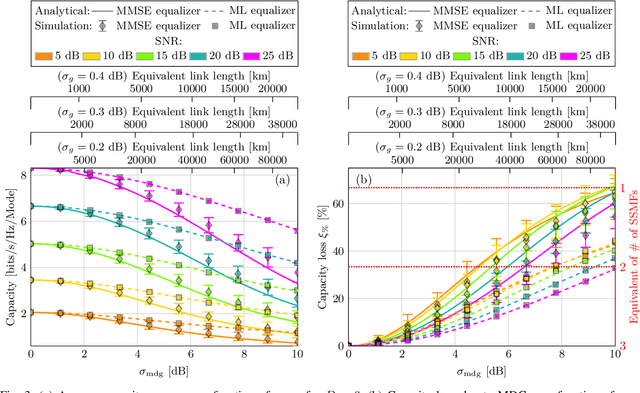Darli A. A. Mello
SDM Optical Systems with MMSE Equalizers: Information Rates and Performance Monitoring
Jan 30, 2025



Abstract:The information rate of coupled space-division multiplexing (SDM) transmission systems is impaired by the stochastic effects of mode-dependent gain (MDG) and mode-dependent loss (MDL), turning it into a random variable and reducing its average value. In systems operating with minimum mean squared error (MMSE) equalizers and no channel-state information (CSI), co-channel interference further reduces the instantaneous and average information rates. Analytical solutions for the average information rate in MDG- and MDL-impaired systems under strong coupling have been presented in early studies assuming ideal maximum-likelihood (ML) equalization. However, to the best of our knowledge, a solution encompassing co-channel interference under MMSE equalization has not been presented yet. In this work, we derive statistical models for the MMSE equalizer coefficients and develop analytical solutions for the post-filtering information rate. We also use these statistical models and analytical solutions to carry out MDG and signal-to-noise ratio (SNR) monitoring in coupled SDM systems. The derived analytical solutions and monitoring techniques are validated by Monte-Carlo simulations, exhibiting a suitable accuracy within practical operational values.
Analytic Models for the Capacity Distribution in MDG-impaired Optical SDM Transmission
Jun 18, 2024



Abstract:In coupled space-division multiplexing (SDM) transmission systems, imperfections in optical amplifiers and passive devices introduce mode-dependent loss (MDL) and gain (MDG). These effects render the channel capacity stochastic and result in a decrease in average capacity. Several previous studies employ multi-section simulations to model the capacity of these systems. Additionally, relevant works derive analytically the capacity distribution for a single-mode system with polarization-dependent gain and loss (mode count D = 2). However, to the best of our knowledge, analytic expressions of the capacity distribution for systems with D > 2 have not been presented. In this paper, we provide analytic expressions for the capacity of optical systems with arbitrary mode counts. The expressions rely on Gaussian approximations for the per-mode capacity distributions and for the overall capacity distribution, as well as on fitting parameters for the capacity cross-correlation among different modes. Compared to simulations, the derived analytical expressions exhibit a suitable level of accuracy across a wide range of practical scenarios.
MDG and SNR Estimation in SDM Transmission Based on Artificial Neural Networks
Dec 20, 2021



Abstract:The increase in capacity provided by coupled SDM systems is fundamentally limited by MDG and ASE noise. Therefore, monitoring MDG and optical SNR is essential for accurate performance evaluation and troubleshooting. Recent works show that the conventional MDG estimation method based on the transfer matrix of MIMO equalizers optimizing the MMSE underestimates the actual value at low SNR. Besides, estimating the optical SNR itself is not a trivial task in SDM systems, as MDG strongly influences the electrical SNR after the equalizer. In a recent work we propose an MDG and SNR estimation method using ANN. The proposed ANN-based method processes features extracted at the receiver after DSP. In this paper, we discuss the ANN-based method in detail, and validate it in an experimental 73-km 3-mode transmission link with controlled MDG and SNR. After validation, we apply the method in a case study consisting of an experimental long-haul 6-mode link. The results show that the ANN estimates both MDG and SNR with high accuracy, outperforming conventional methods.
 Add to Chrome
Add to Chrome Add to Firefox
Add to Firefox Add to Edge
Add to Edge